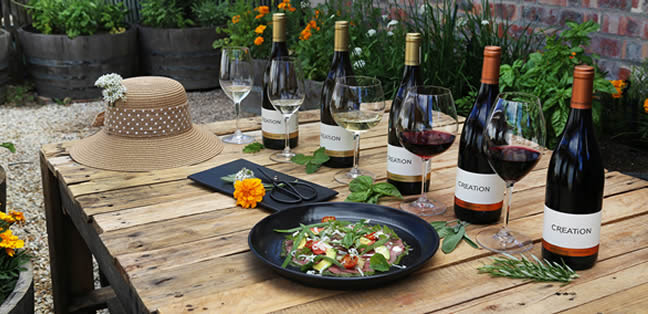Making the Freshest Taste Fresher
In the third instalment of our series on herb and wine pairing Creation’s chef Warwick Taylor sets out to prove once more just how the elegance and finesse of our cool climate wines enhance the taste of fresh herbs when used in considered quantities.
Firstly a few words on the three herbs that he used for his recipe:
Oregano
Oregano is related to the herb marjoram and is sometimes referred to as ‘wild marjoram’. Oregano has purple flowers and spade-shaped, olive-green leaves. It is a perennial, although it is grown as an annual in colder climates, as it often does not survive the winter. Oregano is an important culinary herb, used for the flavour of its leaves, which can be more flavourful when dried than fresh. It has an aromatic, warm and slightly bitter taste, which can vary in intensity.
Wild Garlic
The long, elliptic leaves of the wild garlic are accompanied by angular flowering stems with umbels of white flowers at the top. This perennial can reach up to 50 cm in height and often grows in large, dense colonies. Wild garlic is a wild relative of chives and originates from Europe and Asia. The pleasing taste combination of sweetness and astringency makes it a favourite in the kitchen, especially when added to risottos or omelettes and sauces to accompany meat and fish. The leaves can be eaten raw or lightly cooked depending on your preference.
Basil
This annual herb, which is native to India, has round, green and often pointed leaves and looks a lot like peppermint to which it is related. Basil is most commonly used fresh in cooked recipes and most of the time it is added at the last minute, as cooking destroys the flavour. Green basil features as a core ingredient in basil pesto and is delicious in green chicken curry. The flavour profile, being peppery and minty with a touch of sweetness, makes it a very versatile ingredient.
And now for chef Warwick’s irresistible pairing: Springbok Tartare with Oregano, Wild Garlic and Basil (click here for the recipe) with the 2014 Creation Syrah, Grenache. “When using herbs in a pairing with this blend, I always recommend choosing these three Mediterranean herbs,” says Warwick. “It is an umami driven blend, and the savoury qualities in these herbs bring out the fruitiness in the wine. The rich texture and slightly sweet tannin finish of the wine quite easily handle the robust, lingering flavours of the herbs.”




